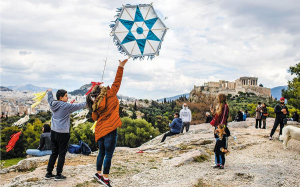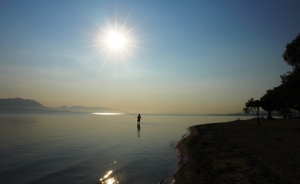XpatAthens
Travel Massive: A Unique Event Dedicated To Greece
The Initiative That Promotes Smoke-Free Venues
If you want to discover a restaurant or bar in your area where smoking is not allowed indoors, all you need to do is check out their ever-growing list of smoke free venues.
Statues At Zappeion Gardens Come To Light
Until recently, the statues became shrouded in darkness at night, making their beauty disappear in the dark. However, about a year ago, Christina Vagena, the chairwoman of the Olympia and Bequests Committee that manages the historic site, decided to reach out to Eleftheria Deko – who recently designed the new lighting system of the Acropolis – to create the new lighting system for 17 of the Zappeion statues. This is worth noting that the internationally acclaimed lighting designer offered her services pro bono.
“It was an enormous honor for such a charismatic professional to offer her assistance free of charge and to breathe new life into the sculptures. When the pandemic blows over, all Athenians will have the pleasure of rediscovering them and enjoying them.”, stated Christina Vagena.
To read this article in full, please visit: greece-is.com
Photo: "Eros", by Georgios Vroutos. © Pavlos Zafiropoulos
How To Ask Something In Greek - Two Useful Verbs
For any Greek language learner, memorizing verbs and learning to conjugate them correctly, is one of the first things you need, in order to make a correct Greek sentence.
Two Greek verbs that many Beginners and even Intermediate students find quite confusing are ρωτάω (rotao) and ζητάω (zitao). The main obvious cause of this confusion is that both verbs mean “to ask” in English. However, in Greek, there is a difference in “asking”!
Both verbs mean to ask, but:
ρωτάω = to ask (a question)
ζητάω = to ask for something
Take a look at the video below, where teacher Marina explains how to use these verbs. The video will also help you with the correct pronunciation.
If you'd like to learn more grammar and do a small exercise to test your knowledge, please visit: omilo.com
Omilo Greek Language and Culture inspires people from all over the world to learn Greek, while exploring Greece. They offer 1- and 2-week courses for adults that combine beautiful course locations, experienced teachers, and a balanced combination of Greek classes with cultural activities. All these make Omilo a place where people enjoy learning modern Greek and have fun.
Besides the courses, Omilo also creates online publications to help adults expand their language skills through Language Books and eBooks for different language levels.
Ready, Steady, Fly & Kali Sarakosti!
Please click HERE to view this issue of our newsletter!
Masks Optional For Pupils As School Starts Again
The use of protective masks (simple surgical or fabric masks with appropriate specifications) is optional for pupils in all classes, teachers, and other staff, as well as for visitors to schools.
However, teachers who remain unvaccinated and uninfected by the Covid-19 coronavirus must have laboratory diagnostic testing (rapid tests or PCR tests) at private diagnostic centers, private clinics, pharmacies, or a private physician at their own expense.
The compulsory laboratory tests are required once per week, before Tuesday up to 48 hours before school attendance.
If the diagnostic test is negative, then a certificate will be issued which the teacher must present to the school to attend classes. If the result of the laboratory diagnostic test is positive, then the relevant protocols of the National Public Health Organization (EODY) will be followed.
If pupils have symptoms outside school, they must remain at home. If students have symptoms at school, the family must be contacted and the child picked up. Until the pupil is collected they must be isolated in a pre-designated well-ventilated area, with supervision, away from other children.
Originally published on: ekathimerini.com
Winter Light In The Greek Islands
The light seems never to be full of Greek beauty. In winter, it is still there, bright as always but somewhat sweeter. It revives the winter colors, whilst the mild temperatures rejuvenate the desire for exploration of Greek beauty. If you believed that islands journey through the winter months in solitude, in the sea while reminiscing the lively summers, the time has come to be informed of the opposite.
Corfu, the cosmopolitan island
Where: The most northern island in the Ionian complex
Why: Stands out due to its refined Italian finesse and the cosmopolitan, Venetian character that impresses throughout the year. Renowned globally as the green island of the Feakes and Odysseus’s final stop before returning to his coveted destination, Ithaca. Corfu is one of the most beautiful islands in the Mediterranean, distinguished by its rich nature, as well as, wonderful attractions.
What to visit: The famous Old Town of Corfu, with the illustrious Esplanade, one of the prettiest piazza’s of Greece, with the Old Fortress on its East and a cricket court on the grounds. Walk through the prominent pathways and admire the unique estates. Enjoy a stroll through the beautiful Liston, adorned by elegant colonnades. Visit the imposing temple of Saint Spyridon, patron saint of the island, with the acclaimed crimson bell tower. Admire the palace of Saint Michael and Saint George, the only “Georgian” style monument in the Mediterranean and the masterpiece, Achilles, 19 kilometers southwest of the city. A trademark locale, is the small island known as Pontikonisi (Mouse island), the brightest gem on the Corfiot crown. We travel through time with Archaeological and Byzantine Museum’s and the Banknote Museum’s impressive exhibits. In the northern region, is the area of Paleokastritsa, known for Aggelokastro – the commanding remains of a Fortress – which along with Kalami and Kassiopi, are some of the most beautiful areas of the islands. While in the southern region you will be astounded by the traditional village of Vatos, as well as, the exquisite habitat of the Korission Lake.
Evia. Endless beauty
Where: Stretching across the northeastern coastline of continental Central Greece
Why: Near Athens and with very easy access, Evia is the second biggest island of Greece and the sixth largest in the Mediterranean. Despite its tourism, Evia’s charm remains intact, enchanting the senses. The numerous beautiful cities, combined with renowned locations and impressive attractions, make Evia the ideal destination, even during the winter season. Its rich geophysical scenery, surrounded by imposing mountains and beautiful lakes, offers visitors a plethora of activities, such as hiking, biking and horseback riding, thus keeping the momentum going at all times.
What to visit: Beautiful Chalkida, the capital of the island, where you can enjoy a stroll on the beach with a background of the famous bridge. You will be able to admire the Castle’s old quarters, distinguished by its architecture, characterized by Turkish and Venetian influences and impressed by the plethora of exhibits in the Archaeological and Folk Museum. The ancient city of Eretria is especially interesting, only 22 kilometers southeast of the Chalkida, which in ancient times was one of the most prestigious areas of Greece, before it’s destruction by the Persians in 490 B.C.
Karistos awaits you in the south of the island, 130 kilometers from Chalkida; a historic city, with beautiful neoclassical buildings, decorated by the exceptional Venetian port of Castelo Rosso. The harbor includes scenes of traditional cafes, picturesque taverns, as well as, restaurants offering gastronomical delicacies that appeal to all taste buds. You will also be able to horseback ride and hike in the beautiful nature and of course blaze your own biking trails. In the northern part of the island, tracing back to the depth of ancient Greece, you will encounter the baths of Edipsos, the most well-known health and wellness center in all of Greece. Also in the north, the settlement of Kimi, with a spectacular view of the sea, is one of the prettiest in the region.
To read more, please see visitgreece.gr
Shrimp Linguine In A Tomato And Feta Sauce
This shrimp linguine is inspired by one of my favourite Greek dishes, shrimp saganaki, where shrimp is cooked in tasty tomato and feta sauce and it works really well as a pasta dish! If you are looking for a quick and easy weeknight meal this recipe fits the bill literally only taking as long to make as it takes to boil the water and to cook the pasta.
When in season, fresh tomatoes, dill and parsley really make this dish sing but otherwise pantry staples, canned diced tomatoes and dried herbs, also work well so you can enjoy this tasty pasta all year round.
Ingredients
240 grams linguine
1 tablespoon olive oil
1 onion, diced
3 cloves garlic, chopped
red chili pepper flakes to taste
1/4 cup white wine or chicken broth
4 cups diced fresh tomatoes or 1 can diced tomatoes
1 teaspoon oregano
1/2 kilo shrimp, peeled and deviened
1/2 cup feta, crumbled
1 tablespoon dill, chopped
1/4 cup parsley, chopped
salt and pepper to taste
Directions
Bring water to a boil in a large pot and cook the pasta as directed on package.
Meanwhile, heat the oil in a pan over medium heat, add the onion and cook until tender, about 5-7 minutes.
Add the garlic and chili pepper flakes and cook until fragrant, about 1 minute.
Add the wine and simmer for a few minutes.
Add the tomatoes and oregano and simmer until the sauce thickens, about 10 minutes
Add the shrimp and and simmer until cooked, about 2-4 minutes.
Mix in the feta, dill and parsley, season with salt and pepper and serve over the linguine.
Option: Add a splash of ouzo or other anise liqueur along with the tomatoes or 1/2 teaspoon ground fennel seeds with the garlic and chili pepper flakes for a hint of the exotic.
Option: Use 1 teaspoon dried dill instead of fresh and add to the sauce along with the oregano.
Tip: Serve with crusty bread to sop up any and all leftover sauce.
Nutrition Facts: Calories 422, Fat 9g (Saturated 3g, Trans 0), Cholesterol 159mg, Sodium 880mg, Carbs 56g (Fiber 4g, Sugars 8g), Protein 27g
By Kevin Lynch
Gov’t Grants Legal Status To Same-Sex Couples
Justice Minister Nikolaos Paraskevopoulos told Parliament that legal cohabitation agreements will be made possible for same-sex couples in Greece, but the adoption of children by gay couples will not be permitted yet.
The new government‘s pledge to grant legal civil partnerships to homosexual couples is in response to a 2013 decision by the Council of Europe’s Court of Human Rights that awarded plaintiffs damages after successfully challenging the Greek state over the civil partnership law that has been available to heterosexual couples since 2008.
However, the support to same-sex marriage does not extend to gay adoptions. “It is a difficult issue that requires dialogue,” said Prime Minister Alexis Tsipras when asked about the subject recently. “There are disputes in the scientific community about this and we will not include it in our policy program.”
To read more, please visit greekreporter.com
By Philip Chrysopoulos











